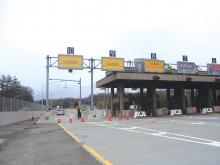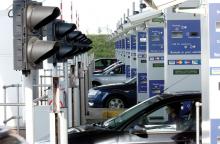Efforts to advance national interoperability for tolling systems are gaining momentum, with one protocol promoted by a key operator group emerging as a candidate to form the basis for full AVI interoperability, Tim McGuckin writes. Fuelled by a growing awareness and acceptance of standards-based solutions, the US toll community is quickening towards the goal of interoperability between toll systems across the US. Over 20 years since the advent of electronic toll collection (ETC), key elements are falling in

Tim McGuckin: Public and private interests vested in preservation of so many variations are starting to diminish
Efforts to advance national interoperability for tolling systems are gaining momentum, with one protocol promoted by a key operator group emerging as a candidate to form the basis for full AVI interoperability, Tim McGuckin writes.
Fuelled by a growing awareness and acceptance of standards-based solutions, the US toll community is quickening towards the goal of interoperability between toll systems across the US. Over 20 years since the advent of electronic toll collection (ETC), key elements are falling into place to present a clearer choice between legacy and open protocols, and to bring interchangeable components that can be selected from lists of qualified products backed up by interoperability certification.The pace of change – which outsiders might say is modest – should be considered exceptional. The US toll community is a conservative group represented by the respected
Until recently, the industry’s struggle towards interoperability was being made that much harder by a lack of examples to build upon; there was little institutional support; no favoured protocol to analyse; and no plan or programme to provide assurance of interoperability if such a protocol was chosen. This is all changing and standards are involved in each step.
Fragmented deployment in short
When ETC began there were no open standards: ETC was using technology repurposed from other sectors, such as railroad security and defence systems. It was adopted for use on existing toll gantries. Operators chose the custom solutions that were available at the time and conditions were ripe for fragmentation. Today there are multiple AVI (automatic vehicle identification) protocols, tag data standards and ICD (interface control document) formats. However, public and private interests vested in preservation of so many variations are starting to diminish.Institutional Support
Complementing growing interest in a new way forward, the industry’s will has become manifest in institutional strength. The Alliance for Toll Interoperability grew in clout and ambition, hosting technology shoot-outs and a toll transaction hub pilot project. IBTTA took perhaps its most serious intellectual stance in support of interoperability (IOP) by testifying to Congress in 2011, promising to achieve IOP on its own in exchange for not having it legislated. IBTTA created an IOP Committee that developed an Interoperability Plan, the putative ‘path forward.’The plan is targeted to be completed by the end of 2012. In a non-technical sense, it is a standard: it was established authoritatively and with general consent as an example or model to follow. IBTTA has also produced several IOP workshops. The May 2011 IOP summit in Plano, Texas, marked a turning point. Theoretical conversations about IOP yielded impatient exchanges, detailed proposals and interesting plans with bold timelines expected to be followed.
Parallel to this, a board of directors was elected to the
Too many technologies
Industry members’ vested interests in particular existing systems are understandable. Each member of the handful of distinct toll regions in the US has invested significantly in its ETC technology. These include E-ZPass, ASTMv6, Title-21, 18000-6C, SeGO, ATA, Allegro and 5.9GHz DSRC; all protocols currently in operation or under test in North America. That asset has considerable value. Regardless of whether the technology is proprietary (E-ZPass, Allegro, SeGO) or ‘open’ (Title-21, ASTMv6, 6C) the argument was that the asset had neither depreciated nor amortized to the point where moving to another protocol made financial sense.That financial argument diminishes, however, when the cost of maintaining legacy protocol is factored in, with limited potential to use that technology for additional services or applications which spread cost to other parties. This is where open standards are far superior to proprietary protocols.
Mention of the 5.9GHz protocol is worthwhile here. In its present tag/OBU form, the current unit cost disqualifies it in the eyes of most operators as a technology to transition towards on grounds of cost. Secondly, although the Connected Vehicle community regards payment services as an important application for the CV platform, the toll industry does not seem to view that protocol’s safety or mobility apps as a vital part of what they are charged with deploying and maintaining. Therefore, 5.9GHz DSRC (dedicated short range communication) fails to resonate as a technology that could reduce costs by applying to further uses.
Others may beg to differ (and some do, passionately), but toll operators are contending with other practical and political factors.
Low cost and mature
What this leaves is 6C as the non-proprietary protocol that offers perhaps the most potential as a transition technology. A 6C tag can be bought for less than $2, a fraction of some proprietary solutions in large use today and savings en masse could justify transition costs via the currently favoured route – the multiprotocol tag reader. 6C is also a fairly mature open technology used in the supply chain community with roughly 20 suppliers and a baseline IOP certification programme established. Toll operators have purchased it as an AVI protocol and other large systems integrators are looking at it for access and transit management, fare collection, parking payment and other ‘integrated transport mobility’ services. Costs could be spread widely and significant non-toll revenues earned.The primary champion for 6C in the US is the 6C User Group (E-470, WashDOT, SRTA and UDOT) which has reported greater accuracy with 6C tag reading in comparison with its members’ other protocols. No problems of interference are reported and money is being saved each year in tag purchases and mailing expenses. But despite the group’s belief in 6C, its members felt they needed a common requirements document and independent test and certification programme. This to ensure that 6C could be considered by the greater toll community as a technology to be adopted as a national standard that returned the full benefits that IOP promises. Enter OCS.
In 2011 OmniAir Certification Services (OCS) was asked by the 6C User Group to help establish an interoperability certification programme for a ‘6C for tolling’ standard. An associated requirements document was completed in July this year. At the time of writing, OCS is open for business and is inviting industry participation in systems testing in August 2012 at a Crofton, Maryland, site provided by OmniAir member Xerox. OCS expects to announce the first certified suppliers in September 2012.
Cautious steps forward
The 6C for tolling IOP certification programme has been designed and created for the 6CUG. That particular group defined the requirements. It may turn out that the 6C protocol will meet the functional, performance and business needs of the entire tolling industry. However, since those needs have not been determined, 6C’s viability as a nationally interoperable technology cannot yet be proven.Fortunately, OmniAir benefits from a tendency toward incrementalism – evolution over revolution. The intention is to continue collaboration with the tolling community to evolve requirements documentation for an ever-larger set of toll operator needs – and develop the technical certification programme accordingly. As for data standards and business rules – two other aspects of IOP – if the community wishes to develop open standards for those elements, OCS is chartered to design the programme, test compliance and award certification.
In conclusion
Full realisation of IOP takes more than abstract support for the concept; more than enlightened industry leaders committed to achieving it; and more than setting of standards. It requires accountability from the representative institutions, operators, suppliers and service providers. OmniAir and OCS were founded to achieve interoperability. Those sharing this inclusive vision should participate as an enabler rather than sit outside competing with it.Tim McGuckin is executive director of the OmniAir Consortium and manager of OmniAir Certification Services






